seats MERCEDES-BENZ E-CLASS CABRIOLET 2018 Owner's Manual
[x] Cancel search | Manufacturer: MERCEDES-BENZ, Model Year: 2018, Model line: E-CLASS CABRIOLET, Model: MERCEDES-BENZ E-CLASS CABRIOLET 2018Pages: 498, PDF Size: 6.28 MB
Page 4 of 498

Atagl ance .................................................... 6
Cockpit ........................................................... 6
Wa rning and indicator lamps .......................... 8
Overhead control panel ................................ 12
Door control panel and seat adjustment ....... 14
Emergencies and breakdowns ...................... 16
DigitalOperator' sManua l........................ .18
Callin g upthe Digital Operator's Manual ...... 18
General notes............................................. 19
Pr otecting the environment .......................... 19
Mercedes-Benz GenuineParts ....................... 19
Operator's Manual ........................................2 0
Service and vehicle operation ....................... 21
Operating saf ety.......................................... .22
Declaration of conformity for wireless
ve hicle components .....................................2 3
Diagnost ics connection ................................ 24
Qualified specialist workshop ....................... 25
Cor rect use of theve hicle ............................2 5
Problems with your vehicle ........................... 25
Re porting saf etydefects .............................. .25
Limited Warranty .......................................... 26 QR codes
forth ere scue card ....................... 26
Ve hicle data storage .....................................2 6
Copyright .. .................................................... 29
Occupant safety......................................... 31
Re stra int sy stem .......................................... .31
Seat belts ..................................................... 33
Airbags ......................................................... 38
Ro ll bar ........................................................ .45
PRE-SAFE
®sy stem ....................................... 46
Children in theve hicle ..................................4 7
No tes on pets in theve hicle .........................5 6
Opening and closing.................................. 57
SmartK ey...................................................... 57
Doors ............................................................ 62
Tr unk ............................................................ 65
Sid ewind ows................................................ 71
Soft top .........................................................7 6
Anti-theft pr otection .................................... .83
Seats and stowing .................................... .85
No tes on the cor rect driver's seat position ... 85 Seats ............................................................ 86
St
eering wheel ............................................. .95
Using the memory function .......................... 98
St ow age areas .............................................. 99
Cup holder .................................................. 105
Ashtr ayand cigar ette lighter ...................... .106
Soc kets ....................................................... 107
Wi reless charging of the mobile phone
and connection with theex terior antenna .. 108
Ins talling or removing thefloor mats ........... 110
Light and visibility .................................... 111
Exterior lighting ........................................... 111
Interior lighting ............................................ 115
Wi ndshield wiper and windshield washer
sy stem ........................................................ 117
Mir rors ........................................................ 120
Operating the sun visors ............................. 123
Climate control ......................................... 124
Overview of climate contro l systems ......... .124
Operating the climate control sy stem ......... 125
2
Conte nts
Page 17 of 498
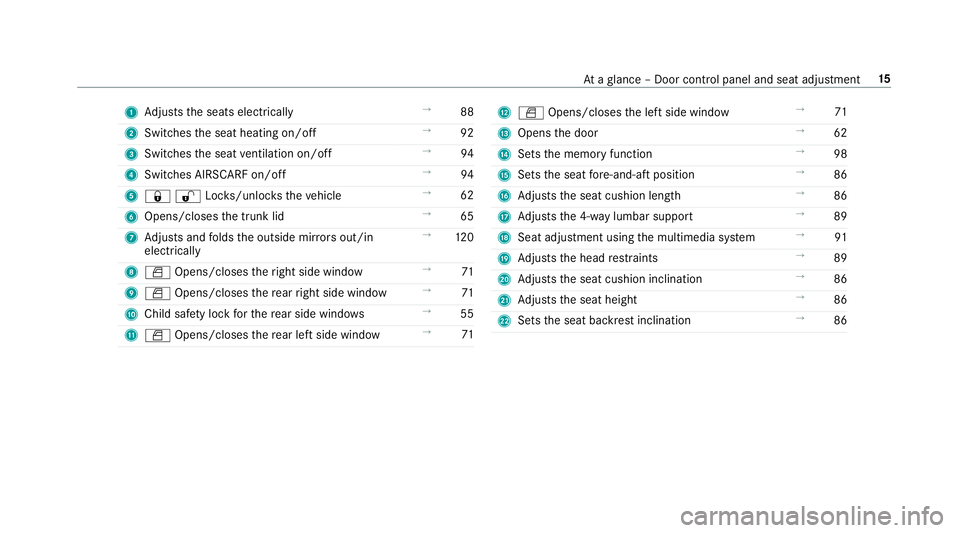
1Adjusts the seats electrically →
88
2 Switches the seat heating on/off →
92
3 Switches the seat ventilation on/off →
94
4 Switches AIRSCARF on/off →
94
5 00370036Loc ks/unloc kstheve hicle →
62
6 Opens/closes the trunk lid →
65
7 Adjusts and folds the outside mir rors out/in
electrically →
120
8 0062 Opens/closes theright side window →
71
9 0062 Opens/closes there ar right side window →
71
A Child safetyloc kfo rth ere ar side wind ows →
55
B 0062 Opens/closes there ar left side wind ow→
71C0062 Opens/closes the left side window →
71
D Opens the door →
62
E Sets the memory function →
98
F Sets the seat fore -and-aft position →
86
G Adjusts the seat cushion length →
86
H Adjusts the 4-w aylumbar support →
89
I Seat adjustment using the multimedia sy stem →
91
J Adjusts the head restra ints →
89
K Adjusts the seat cushion inclination →
86
L Adjusts the seat height →
86
M Sets the seat backrest inclination →
86
Ataglance – Door control panel and seat adjustment 15
Page 22 of 498

0075NO
TEImpairment of the operating ef fi‐
ciency of there stra int sy stems from
ins talling accessories or from repairs or
we lding
Airbags, Emer gency Tensioning Devices, as
we ll as control units and sensors forth e
re stra int sy stems, may be ins talled in thefo l‐
lowing areas of your vehicle:
RDoors
RDoor pillars
RDoor sills
RSeats
RCo ckpit
RInstrument clus ter
RCente r console
00BBDo not ins tall accessories such as audio
sy stems in these areas.
00BBDo not car ryout repairs or welding.
00BBHave accessori esretrofitted at a quali‐
fi ed specialist workshop.
Yo u could jeopardize the operating saf etyof your
ve hicle if you use parts, tires and wheels as well
as accessories releva nt tosaf etywhic hha ve not
been appr ovedby Mercedes-Benz. Saf ety-re le‐
va nt sy stems, e.g. the brake sy stem, may mal‐
function. Only use Mercedes-Benz GenuineParts
or parts of equal quality. Only use tires, wheels
and accessory parts that ha vebeen specifically
appr ovedfo ryo ur vehicle model.
Mercedes-Benz GenuineParts are subject to
st rict quality control. Each part has been spe‐
cially de veloped, manufactured or selecte dfo r
Mercedes-Benz vehicles and fine-tuned forth em.
Therefore, only Mercedes-Benz GenuineParts
should be used.
More than 300,000 dif fere nt Mercedes-Benz
GenuineParts are available for Mercedes-Benz
models.
All au thorized Mercedes-Benz Centers maintain
a supply of Mercedes-Benz GenuineParts for
necessary service and repair work. In addition,
st ra tegically located parts-delivery centers pro‐
vide forqu ick and reliable parts service. Alw
ays specify theve hicle identification number
(VIN) (→page 385) when ordering Mercedes-
Benz GenuineParts.
Operator's Manual
This Operator's Manual describes all models and
all standard and optional equipment available for
yo ur vehicle at the time of this Opera tor's Man‐
ual going topress. Countr y-specific dif fere nces
are possible. No tethat your vehicle may not be
equipped with all features descri bed. This also
applies tosaf ety-re leva nt sy stems and functions.
Therefore, the equipment on your vehicle may
dif fer from that in the descriptions and illustra‐
tions.
The original pur chase contract documentation
fo ryo ur vehicle contains a list of all of the sys‐
te ms in your vehicle.
Should you ha veany questions concerning
equipment and operation, please consult an
authorized Mercedes-Benz Center.
The Operator's Manual and Maintenance Booklet
are impor tant documents and should be kept in
th eve hicle.
20
General no tes
Page 36 of 498
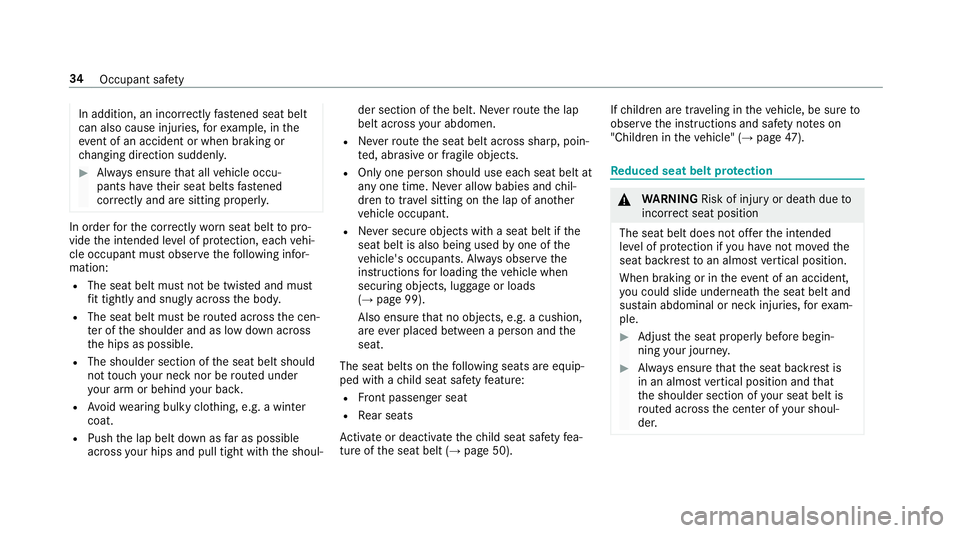
In addition, an incorrectly fastened seat belt
can also cause injuries, forex ample, in the
ev ent of an accident or when braking or
ch anging direction suddenly .
00BBAlways ensure that all vehicle occu‐
pants ha vetheir seat belts fastened
cor rectly and are sitting prope rly.
In order forth e cor rectly wornseat belt topro‐
vide the intended le vel of pr otection, each vehi‐
cle occupant must obser vethefo llowing infor‐
mation:
RThe seat belt must not be twis ted and must
fi t tightly and snugl yacross the body.
RThe seat belt must be routed across the cen‐
te r of the shoulder and as low down across
th e hips as possible.
RThe shoulder section of the seat belt should
not touch your ne cknor be routed under
yo ur arm or behind your bac k.
RAvoid wearing bulky clo thing, e.g. a winter
coat.
RPush the lap belt down as far as possible
across your hips andpulltight withth e shoul‐ der section of
the belt. Ne verro ute the lap
belt across your abdomen.
RNe verro ute the seat belt across sharp, poin‐
te d, abrasive or fragile objects.
ROnly one person should use each seat belt at
any one time. Ne ver all owbabies and chil‐
dren totrave l sitting on the lap of ano ther
ve hicle occupant.
RNe ver secure objects with a seat belt if the
seat belt is also being used byone of the
ve hicle's occupants. Alw ays obser vethe
instructions for loading theve hicle when
securing objects, luggage or loads
(
→page 99).
Also ensure that no objects, e.g. a cushion,
are ever placed between a person and the
seat.
The seat belts on thefo llowing seats are equip‐
ped with a
ch ild seat saf etyfe at
ure:
RFront passenger seat
RRe ar seats
Ac tivate or deacti vate thech ild seat saf etyfe a‐
ture of the seat belt (
→page 50). If
ch ildren are tr aveling in theve hicle, be sure to
obser vethe instructions and saf etyno tes on
"Children in theve hicle" (
→page 47).
Re duced seat belt pr otection
0071
WARNING Risk of injury or death dueto
incor rect seat position
The seat belt does not of ferth e intended
le ve l of pr otection if you ha venot mo vedth e
seat backrest toan almost vertical position.
When braking or in theev ent of an accident,
yo u could slide underneath the seat belt and
sus tain abdominal or neck injuries, forex am‐
ple.
00BBAd just the seat proper lybefore begin‐
ning your journe y.
00BBAlways ensure that the seat backrest is
in an almost vertical position and that
th e shoulder section of your seat belt is
ro uted across the center of your shoul‐
der.
34 Occupant saf ety
Page 42 of 498
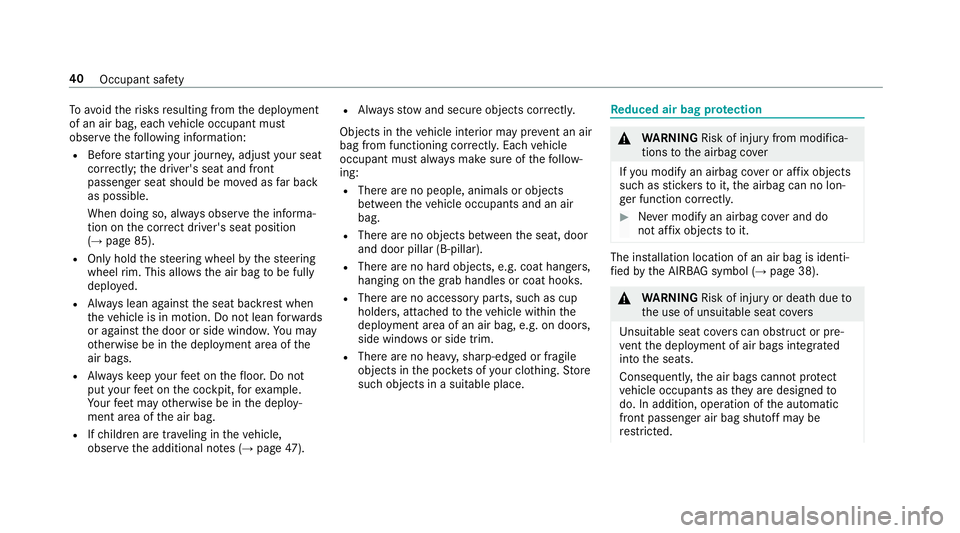
Toavo idtherisks resulting from the deployment
of an air bag, each vehicle occupant must
obser vethefo llowing information:
RBefore starting your journe y,adjust your seat
co rrectly ;th e driver's seat and front
passenger seat should be mo ved as far back
as possible.
When doing so, alw ays obser vethe informa‐
tion on the cor rect driver's seat position
(
→page 85).
ROnly hold thesteering wheel bythesteering
wheel rim. This all owsth e air bag tobe fully
deplo yed.
RAlw ays lean against the seat backrest when
th eve hicle is in motion. Do not lean forw ards
or against the door or side windo w.You may
ot herwise be in the deployment area of the
air bags.
RAlw ayske ep your feet on thefloor. Do not
put your feet on the cockpit, forex ample.
Yo ur feet may otherwise be in the deploy‐
ment area of the air bag.
RIfch ildren are tra veling in theve hicle,
obser vethe additional no tes (→page 47).
RAlw aysstow and secure objects cor rectl y.
Objects in theve hicle interior may pr event an air
bag from functioning cor rectl y.Each vehicle
occupant must alw ays make sure of thefo llow‐
ing:
RThere are no people, animals or objects
between theve hicle occupants and an air
bag.
RThere are no objects between the seat , door
and door pillar (B-pillar).
RThere are no hard objects, e.g. coat hangers,
hanging on the grab handles or coat hooks.
RThere are no accessory parts, such as cup
holders, attached totheve hicle within the
deployment area of an air bag, e.g. on doors,
side windo wsor side trim.
RThere are no heavy, sharp-edged or fragile
objects in the poc kets of your clo thing. Store
such objects in a suitable place.
Re duced air bag pr otection
0071
WARNING Risk of injury from modifica‐
tions tothe airbag co ver
If yo u modify an airbag co ver or af fix objects
such assticke rs to it,the airbag can no lon‐
ge r function cor rectl y.
00BBNe ver modify an airbag co ver and do
not af fix objects toit.
The ins tallation location of an air bag is identi‐
fi ed bythe AIRB AGsymbol (→page 38).
0071
WARNING Risk of injury or death dueto
th e use of unsuitable seat co vers
Uns uitable seat co vers can obstruct or pre‐
ve nt the deployment of air bags integrated
into the seats.
Consequentl y,the air bags cannot protect
ve hicle occupants as they are designed to
do. In addition, operation of the automatic
front passenger air bag shutoff may be
re stricted.
40
Occupant saf ety
Page 43 of 498
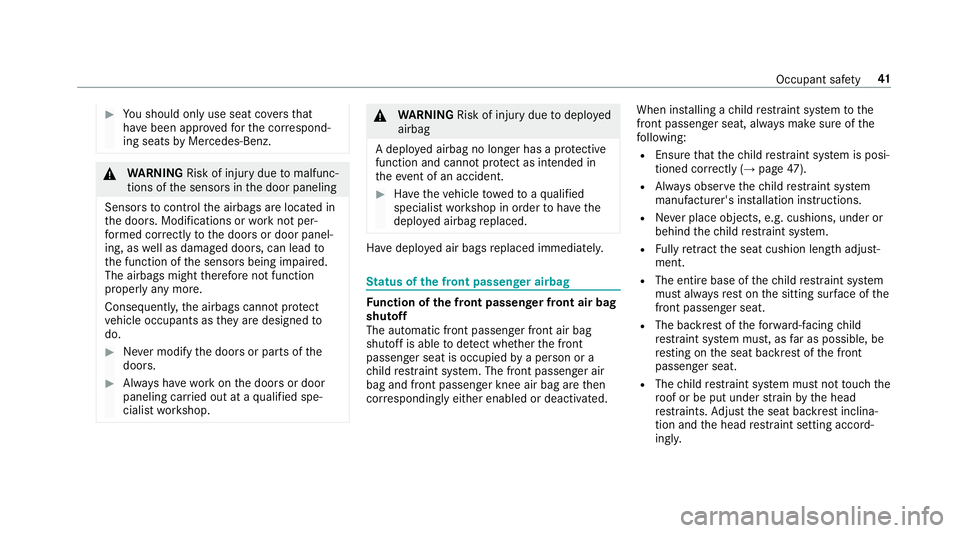
00BBYou should only use seat covers that
ha ve been appr oved forth e cor respond‐
ing seats byMercedes-Benz.
0071
WARNING Risk of injury duetomalfunc‐
tions of the sensors in the door paneling
Sensors tocontrol the airbags are located in
th e doors. Modifications or worknot per‐
fo rm ed cor rectly tothe doors or door panel‐
ing, as well as damaged doors, can lead to
th e function of the sensors being impaired.
The airbags might therefore not function
proper lyany more.
Consequent ly,th e airbags cannot protect
ve hicle occupants as they are designed to
do.
00BBNe ver modify the doors or parts of the
doors.
00BBAlw ays ha vewo rkon the doors or door
paneling car ried out at a qualified spe‐
cialist workshop.
0071
WARNING Risk of injury duetodeplo yed
airbag
A deplo yed airbag no longer has a pr otective
function and cann otprotect as intended in
th eev ent of an accident.
00BBHa ve theve hicle towe dto aqu alified
specialist workshop in order tohave the
deplo yed airbag replaced.
Ha ve deplo yed air bags replaced immediately.
St atus of the front passenger airbag
Fu nction of the front passenger front air bag
shuto ff
The automatic front passenger front air bag
shutoff is able todetect whe ther the front
passenger seat is occupied bya person or a
ch ild restra int sy stem. The front passenger air
bag and front passenger knee air bag are then
cor respondingly either enabled or deactivated. When ins
talling a child restra int sy stem tothe
front passenger seat, alw ays make sure of the
fo llowing:
REnsure that thech ild restra int sy stem is posi‐
tioned cor rectly (→page 47).
RAlw ays obser vethech ild restra int sy stem
manufacturer's ins tallation instructions.
RNe ver place objects, e.g. cushions, under or
behind thech ild restra int sy stem.
RFu lly retract the seat cushion length adjust‐
ment.
RThe entire base of thech ild restra int sy stem
must alw aysre st on the sitting sur face of the
front passenger seat.
RThe backrest of thefo rw ard-facing child
re stra int sy stem must, as far as possible, be
re sting on the seat backrest of the front
passenger seat.
RThe child restra int sy stem must not touch the
ro of or be put under stra in by the head
re stra ints. Adjust the seat backrest inclina‐
tion and the head restra int setting accord‐
ing ly.
Occupant saf ety 41
Page 52 of 498

RInstructions and safetyno tes on the auto‐
matic front passenger airbag shutoff
(
→page 41).
RSaf etyno tes on the seat belt (→page 33).
RInformation on the cor rect use of the seat
belt (→page 38).
Ac tivating/deactivating the child seat saf ety
fe ature of the seat belt
0071
WARNING Risk of injury or death if a
seat belt is unfas tened while theve hicle
is in motion
If th e seat belt is released while theve hicle is
in motion, thech ild restra int sy stem is no
longer cor rectly secure d. Thechild seat
saf etyfe ature is deactivated and the seat
belt is dr awn in a bit bythe inertia reel.
It is therefore not possible toengage the seat
belt again.
00BBPull over and stop theve hicle safely as
soon as possible, paying attention to
ro ad and traf fic conditions.
00BBAc tivate thech ild seat saf etyfe ature
again and cor rectly secure thech ild
re stra int sy stem.
When enabled, thech ild seat saf etyfe ature
ensures that the seat belts of the front
passenger seat and rear seats do not slac ken
once thech ild restra int sy stem is secured.
Installing a child restra int sy stem:
00BBAlw ays comply with the manufacturer's
ins tallation instructions when ins talling and
re moving thech ild restra int sy stem.
00BBPull the seat belt smoo thly from the seat belt
outlet.
00BBEn gage the seat belt tongue in the seat belt
buckle.
Ac tivating the child seat saf etyfe ature:
00BBPull the seat belt out fully and let the inertia
re el retract it again.
When thech ild seat saf etyfe ature is activa‐
te d,you should hear a ratcheting sound.
00BBPush thech ild restra int sy stem down until
th e seat belt sits tightly. Deactivating the
child seat saf etyfe ature:
00BBPress there lease button of the seat belt
buckle.
00BBHold the seat belt tongue and guide it ba ck
to the seat belt outlet.
LA TC H-type (ISOFIX) child seat attachment
Note s onLATC H-type (ISOFIX) child seat
attachments
0071 WARNING Risk of‑ injury or death ifthe
maximum permissible gross mass for
using a LATC H-type (ISOFIX) child
re stra int sy stem is exceeded
Fo rLA TC H-type (ISOFIX) child restra int sys‐
te ms in which thech ild is secured using the
integrated seat belt integrated in thech ild
re stra int sy stem, the permissible gross mass
of thech ild and child restra int sy stem is
73 lb (33 kg).
If th ech ild and thech ild restra int sy stem
to ge ther we igh more than 73 lb (33 kg),th e
50
Occupant saf ety
Page 53 of 498
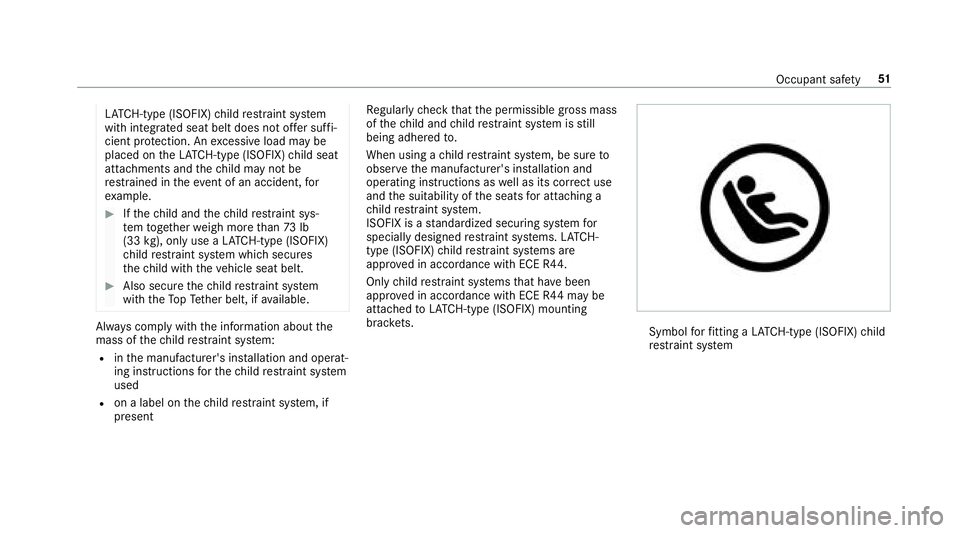
LATC H-type (ISOFIX) child restra int sy stem
with integrated seat belt does not of fer suf fi‐
cient pr otection. An excessive load may be
placed on theLA TC H-type (ISOFIX) child seat
attachments and thech ild may not be
re stra ined in theeve nt of an accident, for
ex ample.
00BBIfth ech ild and thech ild restra int sys‐
te m toget her weigh more than 73 lb
(33 kg),only use a LATC H-type (ISOFIX)
ch ild restra int sy stem which secures
th ech ild with theve hicle seat belt.
00BBAlso secure thech ild restra int sy stem
with theTo pTe ther belt, if available.
Alw ays comply with the information about the
mass of thech ild restra int sy stem:
Rin the manufacturer's ins tallation and operat‐
ing instructions forth ech ild restra int sy stem
used
Ron a label on thech ild restra int sy stem, if
present Re
gular lych eck that the permissible gross mass
of thech ild and child restra int sy stem is still
being adhered to.
When using a child restra int sy stem, be sure to
obser vethe manufacturer's ins tallation and
operating instructions as well as its cor rect use
and the suitability of the seats for attaching a
ch ild restra int sy stem.
ISOFIX is a standardized securing sy stem for
specially designed restra int sy stems. LATC H-
type (ISOFIX) child restra int sy stems are
appr oved in accordance with ECE R44.
Only child restra int sy stems that ha vebeen
appr oved in accordance with ECE R44 may be
attached toLATC H-type (ISOFIX) mounting
brac kets.
Symbol forfitting a LATC H-type (ISOFIX) child
re stra int sy stem
Occupant saf ety 51
Page 54 of 498
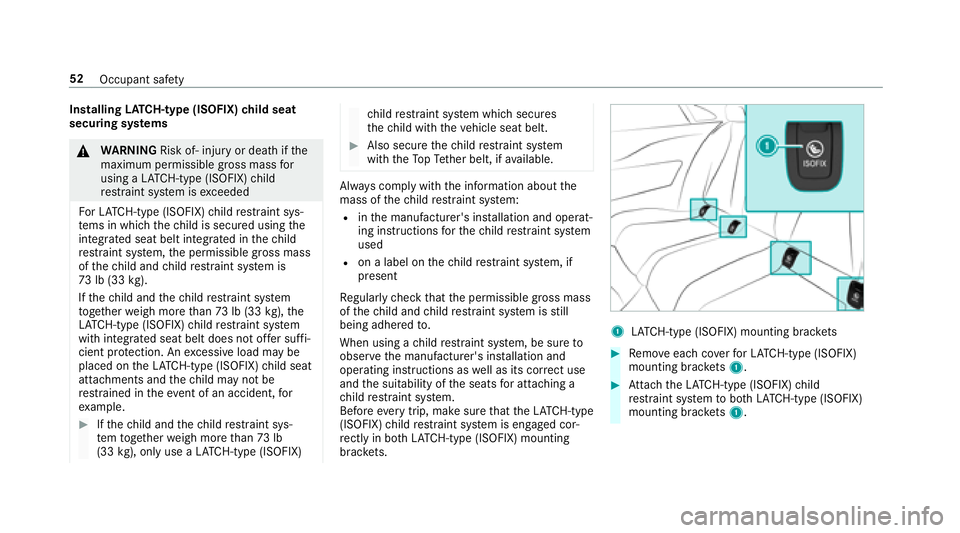
InstallingLATC H-type (ISOFIX) child seat
securing sy stems
0071
WARNING Risk of‑ injury or death ifthe
maximum permissible gross mass for
using a LATC H-type (ISOFIX) child
re stra int sy stem is exceeded
Fo rLA TC H-type (ISOFIX) child restra int sys‐
te ms in which thech ild is secured using the
integrated seat belt integrated in thech ild
re stra int sy stem, the permissible gross mass
of thech ild and child restra int sy stem is
73 lb (33 kg).
If th ech ild and thech ild restra int sy stem
to ge ther we igh more than 73 lb (33 kg),th e
LA TC H-type (ISOFIX) child restra int sy stem
with integrated seat belt does not of fer suf fi‐
cient pr otection. An excessive load may be
placed on theLA TC H-type (ISOFIX) child seat
attachments and thech ild may not be
re stra ined in theeve nt of an accident, for
ex ample.
00BBIfth ech ild and thech ild restra int sys‐
te m toget her weigh more than 73 lb
(33 kg),only use a LATC H-type (ISOFIX)
child restra int sy stem which secures
th ech ild with theve hicle seat belt.
00BBAlso secure thech ild restra int sy stem
with theTo pTe ther belt, if available.
Alw ays comply with the information about the
mass of thech ild restra int sy stem:
Rin the manufacturer's ins tallation and operat‐
ing instructions forth ech ild restra int sy stem
used
Ron a label on thech ild restra int sy stem, if
present
Re gular lych eck that the permissible gross mass
of thech ild and child restra int sy stem is still
being adhered to.
When using a child restra int sy stem, be sure to
obser vethe manufacturer's ins tallation and
operating instructions as well as its cor rect use
and the suitability of the seats for attaching a
ch ild restra int sy stem.
Before everytrip, make surethat theLA TC H-type
(ISOFIX) child restra int sy stem is engaged cor‐
re ctly in bo thLATC H-type (ISOFIX) mounting
brac kets.
1LA TC H-type (ISOFIX) mounting brac kets
00BBRe mo veeach co verfo rLA TC H-type (ISOFIX)
mounting brac kets 1.
00BBAttach theLA TC H-type (ISOFIX) child
re stra int sy stem toboth LATC H-type (ISOFIX)
mounting brac kets 1.
52
Occupant safe ty
Page 56 of 498

00BBSecurethech ild restra int sy stem with
LA TC H-type (ISOFIX) (→page 52).
00BBTension TopTe ther belt 3from the trunk.
00BBMake sure that there is suf ficient seat belt
st ra pto pull tight.
00BBAlw ays comply with thech ild restra int sys‐
te m manufacturer's ins tallation instructions
when doing so.
Child restra int sy stems on the front
passenger seat
Note s onchild restra int sy stems on the front
passenger seat
Ac cident statistics show that children secured in
th ere ar seats are safer than children secured in
th e front seats. Forth is reason, Mercedes-Benz
stro ngly advises that you ins tall a child restra int
sy stem on a rear seat.
If it is absolutely necessary toins tall a child
re stra int sy stem on the front passenger seat,
alw ays obser vethe information on the automatic
front passenger airbag shutoff (
→page 41). By doing
this, you can avoidrisks caused by:
RAch ild restra int sy stem that is not de tected
by the automatic front passenger airbag
shutoff.
RThe unintentionally deactivated front
passenger airbag.
RIncor rect positioning of thech ild restra int
sy stem.
Note s onforw ard-facing and rear wa rd-facing
ch ild restra int sy stems on the front
passenger seat
When using a rear wa rd-facing child restra int sys‐
te m on the front passenger seat, the front
passenger front air bag must alw ays be deactiva‐
te d. This is only the case if thePA SSENGER AIR
BA G OFF indicator lamp is lit continuously
(
→page 43).
When using thech ild restra int sy stem on the
front passenger seat, it is essential toobser ve
th efo llowing:
RMo vethe front passenger seat as far back as
possible.
RSet the seat backrest toan almost vertical
position.
RRe tract the seat cushion length as far as pos‐
sible.
RThe entire base of thech ild restra int sy stem
must alw aysre st on the sitting sur face of the
front passenger seat.
RThe backrest of thefo rw ard-facing child
re stra int sy stem must lie as flat as possible
against the seat backrest of the front
passenger seat. The child restra int sy stem
must not touch thero of or be put under
st ra in by the head restra ints.
RIf necessar y,adjust the angle of the seat
backrest and the head restra int position
according ly.
RAd just the seat cushion inclination so that
th e front edge of the seat cushion is in the
highest position and there ar edge of the
seat cushion is in the lo west position.
RAlways make sure that the shoulder belt
st ra p is cor rectly routed from the seat belt
outlet of theve hicle tothe shoulder belt
guide on thech ild restra int sy stem. The
54
Occupant saf ety